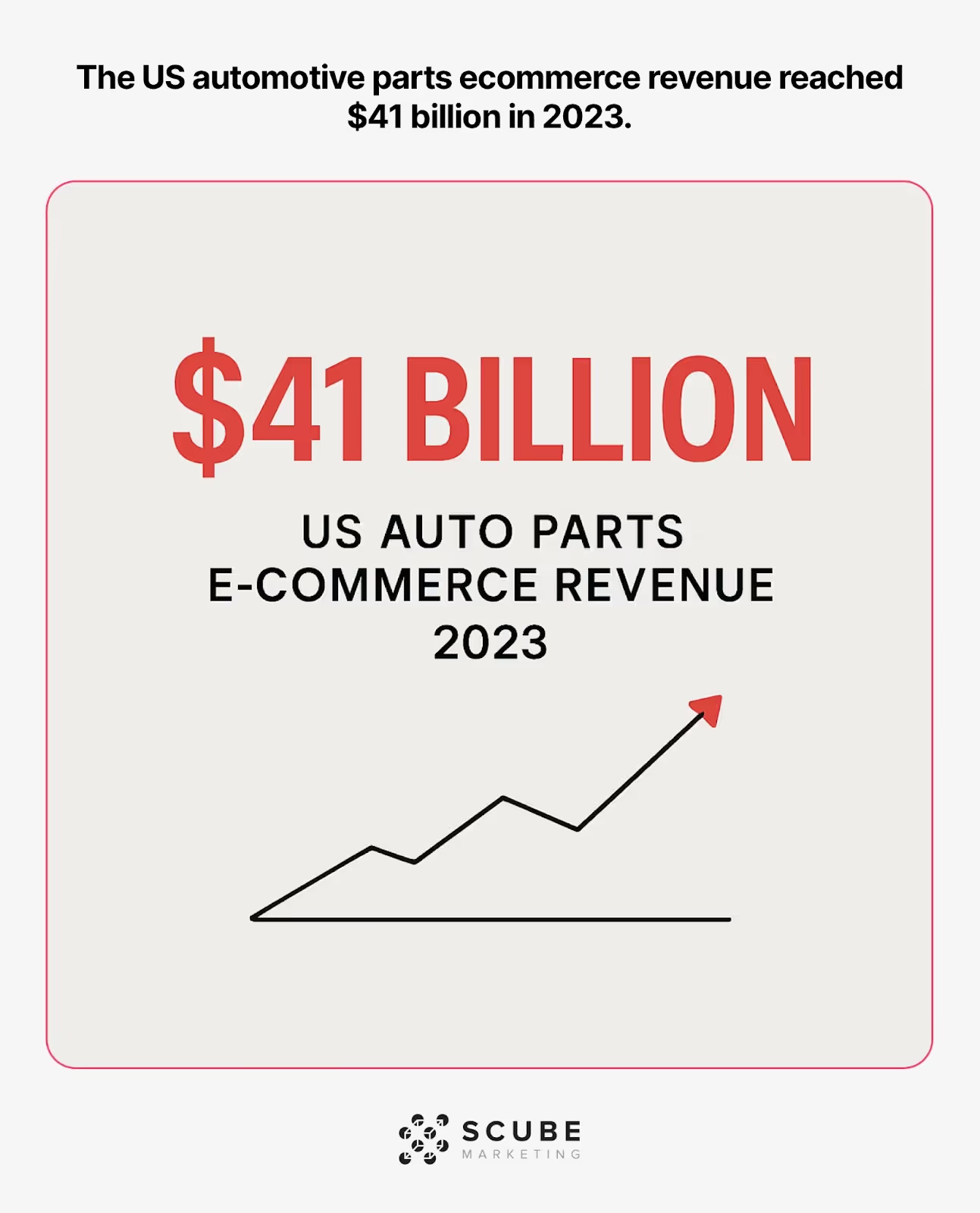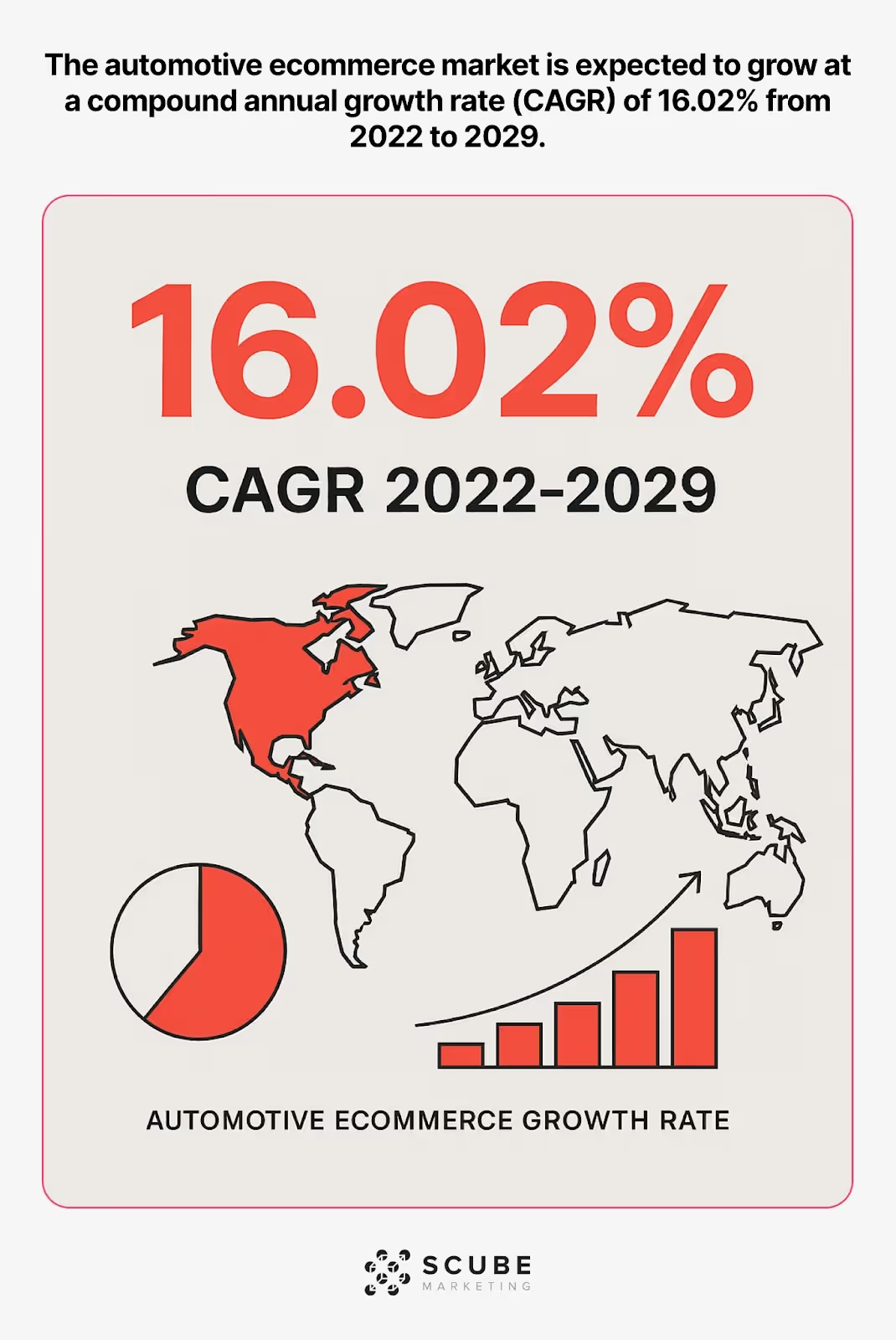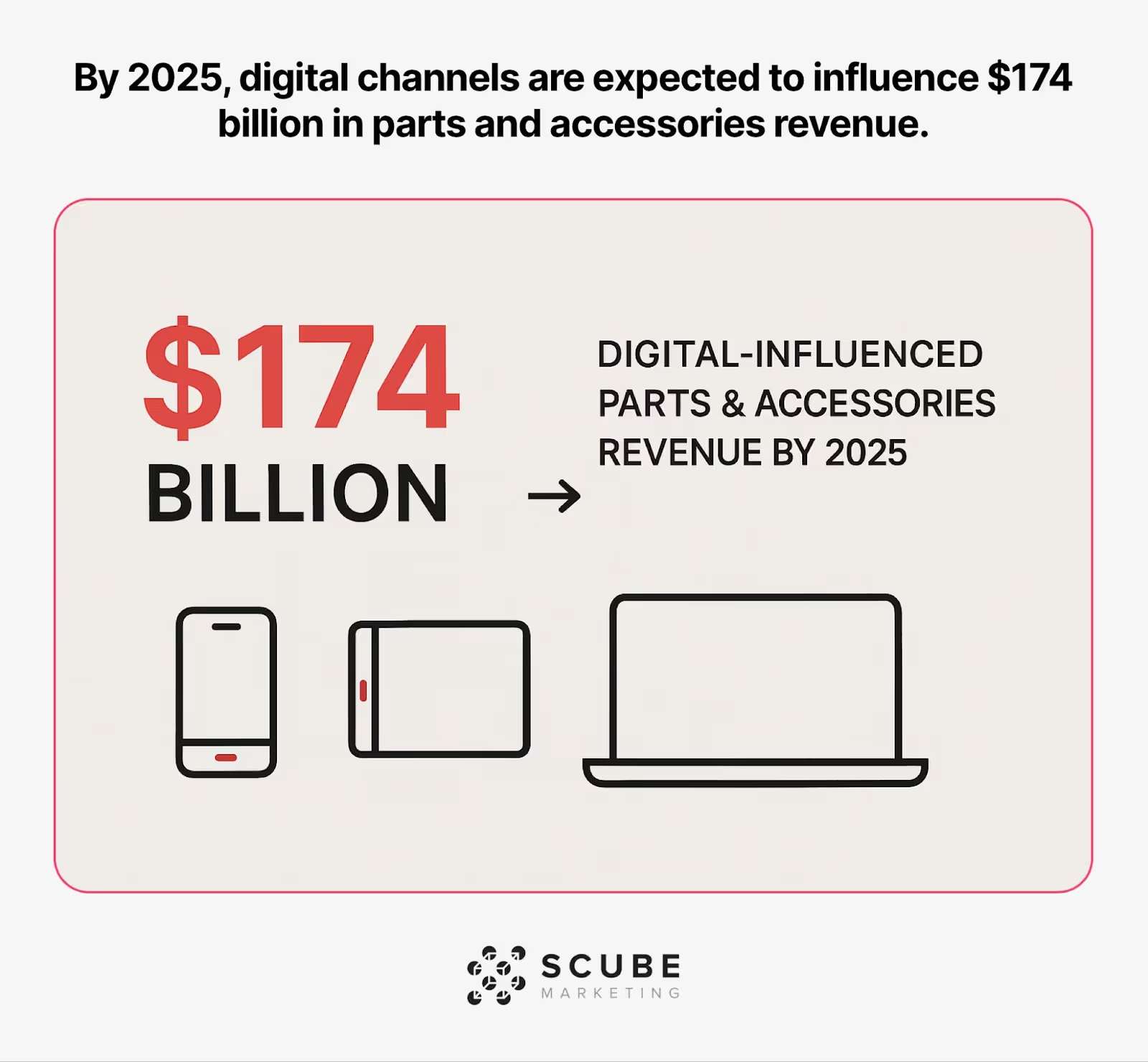
Product descriptions make or break auto parts sales. They're your virtual salespeople, explaining why a specific part is perfect for a customer's vehicle. In the auto parts world, details matter tremendously. Every specification, compatibility note, and feature description directly impacts conversion rates.
I've worked with numerous automotive parts retailers over the years, and one consistent pattern emerges: businesses that invest in quality product descriptions see significantly higher conversion rates than those using generic manufacturer content. It's not just about having information; it's about having the right information presented the right way.

The automotive ecommerce space is booming. The US automotive parts ecommerce revenue reached $41 billion in 2023. (Source: Hedges Company) With such significant market opportunity, optimizing your product descriptions gives you a competitive edge in capturing more of this growing market.
In this guide, I'll share proven strategies for creating auto parts product descriptions that convert. We'll cover everything from technical specifications to storytelling techniques, all designed to help you sell more parts online.
Auto parts ecommerce is growing rapidly. The entire sector continues to expand year after year, presenting tremendous opportunities for online retailers. Understanding this landscape helps contextualize why effective product descriptions matter so much in this industry.
Let's look at some key market statistics that highlight the importance of optimizing your auto parts product pages:
The North American region dominates the automotive ecommerce industry, accounting for 39.9% of the global market share. This regional strength creates both opportunity and competition for auto parts sellers.

Global growth projections are equally impressive. The automotive ecommerce market is expected to grow at a compound annual growth rate (CAGR) of 16.02% from 2022 to 2029. By 2029, the global automotive ecommerce market is projected to reach $213.08 billion.

Auto parts shoppers face unique challenges. Unlike general merchandise, auto parts must be compatible with specific vehicle makes, models, and years. Buyers need absolute certainty that a part will fit their vehicle before purchasing. This makes detailed, accurate product descriptions essential.
The technical nature of auto parts adds another layer of complexity. Many customers have varying levels of mechanical knowledge. Your descriptions must simultaneously satisfy experienced mechanics while remaining accessible to DIY enthusiasts who may need more guidance.
Finally, the visual similarity of many parts means customers rely heavily on descriptions to differentiate products. Two seemingly identical parts might have crucial differences in materials, durability, or performance characteristics that only a detailed description can properly convey.
Effective auto parts descriptions follow a clear formula. They combine technical precision with persuasive marketing language. The best descriptions transform complex specifications into compelling reasons to buy.
When analyzing successful auto parts retailers, I've identified several critical elements that consistently appear in high-converting product descriptions:
Vehicle compatibility information comes first. This critical element immediately tells shoppers whether the part will work with their specific vehicle. Many successful auto parts retailers implement year-make-model selectors to filter compatible parts, but the description should still reinforce this information.
Technical specifications provide necessary details for comparison. Include all relevant measurements, weights, materials, and fitment information. These details help customers confidently choose between similar options while also supporting your ecommerce SEO strategy through relevant keyword inclusion.
Benefits-focused content connects features to outcomes. Rather than simply listing specifications, explain why they matter. For example, instead of just noting "stainless steel construction," add "the stainless steel construction prevents rust and corrosion, extending the part's lifespan even in harsh weather conditions."
Installation information reduces purchase anxiety. Many auto parts shoppers worry about whether they can successfully install a part themselves. Including difficulty level, required tools, and estimated installation time helps customers assess whether the part fits their skill level.
Quality indicators establish value and credibility. Information about warranties, manufacturer reputation, OEM specifications, and certifications helps justify price points and builds confidence in the product's reliability and performance.
Auto parts buyers have specific concerns. They need answers before making a purchase. Effective descriptions anticipate and address these questions proactively.
Understanding your customers' search intent is crucial. Auto parts shoppers typically fall into several categories: DIY enthusiasts, professional mechanics, restoration specialists, and performance upgraders. Each segment has different priorities and knowledge levels.
Here are the most common questions auto parts shoppers need answered before making a purchase:
Balancing technical details with user benefits creates compelling descriptions. Technical specifications establish credibility and help customers verify compatibility. Benefits explain why those specifications matter and how they improve the vehicle's performance, appearance, or reliability.
For example, a performance air filter description might include technical specs like filter media composition and airflow ratings. The benefits translation explains how these specs deliver increased horsepower, improved fuel economy, and longer service intervals.
Mobile optimization matters tremendously in auto parts shopping. Many customers research parts while in their garage or at an auto shop. Prioritize scannable content with bullet points for specifications and clear section headings. This organization helps mobile users quickly find the specific information they need.
How can auto parts sellers succeed online? Start by organizing descriptions in a consistent format across products. This predictable structure helps shoppers quickly locate the information most important to them, reducing friction in the buying process.
Technical specifications form the backbone of auto parts descriptions. They provide the concrete information buyers need to make informed decisions. However, not all specifications carry equal weight across all part categories.
Different parts require different specification emphasis. Here are the most critical specifications by major part category:
Compatibility information represents the most critical specification. Your description should clearly communicate what vehicles the part fits, including make, model, year ranges, and any specific trim levels or engine configurations. Being specific prevents returns and customer frustration.
The following table highlights important material quality indicators that should be included in product descriptions:
Performance metrics help customers compare options. Include relevant measurements like horsepower gains, efficiency improvements, weight reduction, or durability ratings. Whenever possible, cite testing methods or certifications that validate these claims.
Warranty and guarantee information builds purchase confidence. Clearly state warranty duration, what's covered, and any special conditions. This information not only reduces purchase anxiety but also signals the manufacturer's confidence in their product quality.
Installation complexity details help customers assess fit with their skill level. Include an estimated difficulty rating, special tools required, and approximate installation time. For complex parts, mentioning whether professional installation is recommended can prevent customer disappointment.
Storytelling transforms technical products into emotional purchases. Even for utilitarian auto parts, narrative elements can significantly boost conversion rates. Effective storytelling connects products to real-world benefits and experiences.
The most effective storytelling techniques for auto parts include:
Creating scenarios that resonate with automotive enthusiasts works particularly well. For performance parts, describe the experience of acceleration, handling, or sound improvements. For maintenance parts, emphasize peace of mind and reliability in challenging conditions.
For example, instead of simply listing specifications for a performance exhaust system, create a scenario: "Imagine pulling away from a stoplight and hearing the deep, authoritative tone as you accelerate – turning heads while gaining the performance benefits of improved exhaust flow and increased horsepower."
The before-and-after transformation narrative creates powerful motivation. Help customers envision the improvement this part will make to their vehicle's performance, appearance, or reliability. This technique is particularly effective for upgrades rather than direct replacements.
Social proof strengthens product descriptions immensely. Incorporating real customer experiences, professional endorsements, or performance testing results adds credibility to your claims. Brief testimonial snippets integrated directly into descriptions can address specific concerns buyers might have.
The principle of conversion rate optimization applies strongly here – testing different storytelling approaches can help you identify which narratives resonate most with your specific customer segments.
SEO drives organic traffic to your product pages. Well-optimized auto parts descriptions help your products appear in relevant searches. The auto parts sector presents unique SEO challenges and opportunities.
Keyword research for auto parts requires specialized approaches. Beyond general terms like "brake pads" or "air filters," successful descriptions incorporate:
1. Make/model/year specific terms (e.g., "2015 Toyota Camry brake pads")
2. Part numbers (both manufacturer and cross-reference)
3. Technical specifications as keywords (e.g., "ceramic brake pads")
4. Problem-based keywords (e.g., "stop brake squealing")
5. Compatibility terms (e.g., "fits F-150 2018-2021")
Structured data implementation significantly benefits auto parts pages. Using appropriate schema markup helps search engines understand product specifications, compatibility information, and technical details. This structured approach can lead to enhanced search results with specification tables, ratings, and availability information.

By 2025, digital channels are expected to influence $174 billion in parts and accessories revenue. (Source: Hedges Company) This projection underscores the growing importance of optimizing your product content for search visibility.
Mobile optimization remains critical for auto parts searches. Many customers research parts on their phones while looking at their vehicles or discussing repairs. Ensure your product descriptions display well on mobile devices with critical information (compatibility, specifications, price) visible without excessive scrolling.
Cross-selling opportunities should be built into descriptions. Mentioning commonly paired items or required additional parts creates natural opportunities for suggesting related products. For example, a brake pad description might mention the importance of also checking brake rotors and calipers.
Aftermarket auto parts sellers succeed in ecommerce by building content clusters around related products. Creating relationships between complementary parts through internal linking helps both SEO performance and average order value.
Testing product descriptions leads to continuous improvement. Systematic optimization can significantly increase conversion rates over time. A data-driven approach reveals what actually works for your specific customers.
Here are effective A/B testing ideas for auto parts product descriptions:
When measuring description effectiveness, track these key metrics:
Implement an iterative improvement process for ongoing optimization. Start by identifying your lowest-performing product descriptions based on conversion metrics. Test new variations, implement successful changes, then move to the next set of products. This methodical approach ensures continuous improvement across your catalog.
Customer feedback provides invaluable insights for description optimization. Pay special attention to customer questions, as they highlight information gaps in your descriptions. When customers repeatedly ask the same questions, that information should be prominently added to your product descriptions.
With online auto parts sales growing rapidly, investing time in description optimization delivers significant returns. Even small improvements in conversion rates can translate to substantial revenue increases when applied across your entire product catalog.
Even small errors can significantly impact conversion rates. Avoiding common pitfalls helps maximize the effectiveness of your product descriptions. Here are the most frequent mistakes and how to fix them:
Technical inaccuracies severely damage credibility and increase returns. Always verify specifications with manufacturers before publishing. Remember that incorrect information doesn't just lose sales – it creates costly returns and damages customer trust.
Ignoring compatibility information is perhaps the most serious mistake. Auto parts shoppers' primary concern is whether a part will fit their specific vehicle. Vague statements like "fits most models" create uncertainty that drives customers to competitors with more precise information.
Generic descriptions fail to differentiate your products. Using manufacturer-provided descriptions verbatim means your content matches dozens of other websites selling the same parts. Customized descriptions that highlight specific benefits and use cases provide a competitive advantage.
Keyword stuffing damages both readability and SEO performance. Modern search engines penalize obvious keyword manipulation. Instead, focus on naturally incorporating relevant terms while maintaining a conversational, helpful tone that prioritizes the customer's needs.
Neglecting mobile optimization increasingly impacts conversion rates. As mentioned earlier, many auto parts research and purchases happen on mobile devices. Ensure your descriptions are easily scannable on small screens with critical information visible without excessive scrolling.
The right tools streamline description creation. They help maintain consistency while improving quality. These resources can transform your product content process.
Here are recommended tools specifically for auto parts content creation:
Product information management systems are particularly valuable for auto parts retailers. These platforms centralize product data, maintain consistency across channels, and streamline updates when specifications change. For large catalogs, a PIM system is nearly essential for quality control.
Industry-specific databases like ACES (Aftermarket Catalog Exchange Standard) and PIES (Product Information Exchange Standard) provide standardized vehicle compatibility and product information. Utilizing these standards ensures your fitment data matches industry expectations.
Content templates create consistency while saving time. Develop templates for different product categories that include all necessary sections: compatibility information, technical specifications, benefits, installation notes, and warranty details. These templates ensure no critical information is overlooked.
SEO tools with automotive industry focus help identify the most valuable keywords. Look for solutions that understand the unique nature of auto parts searches, including make/model/year combinations and technical specifications that serve as important search terms.
Analytics platforms reveal which description elements drive conversions. Implement tools that can correlate product page elements with conversion rates. This data helps you understand which information most influences purchase decisions for your specific customer base.
Creating quality descriptions at scale requires a system. A well-designed process ensures consistency while managing resources efficiently. This approach is particularly important for auto parts retailers with large product catalogs.
Start by prioritizing your product catalog. Focus first on your best-selling items and those with the highest margins. These high-impact products deserve the most attention. Then address products with high traffic but low conversion rates, as these present the greatest immediate opportunity for improvement.
Develop a standardized template system for different product categories. Each template should include all essential sections while accommodating category-specific information. For example, brake components need different emphasis than exterior accessories.
Consider this template structure for most auto parts:
1. Opening benefit statement (what problem this solves)
2. Compatibility information (year/make/model fitment)
3. Key technical specifications (measurements, materials, ratings)
4. Performance benefits (how it improves the vehicle)
5. Installation information (difficulty, special tools, estimated time)
6. Quality/warranty information (guarantees, certifications)
7. Recommendations for related parts or accessories
Batch similar products for efficient description writing. Creating descriptions for all your brake pads at once, for example, allows you to maintain consistent terminology while efficiently researching the category-specific information. This approach is more efficient than randomly moving between different product types.
Implement a quality control process with technical verification. Have someone with automotive knowledge review descriptions for technical accuracy before publishing. This extra step prevents costly errors that could damage credibility and increase return rates.
Finally, create a regular update schedule for your product descriptions. Set calendar reminders to review and refresh content for seasonal relevance, new vehicle compatibility, or changing market conditions. This ongoing maintenance ensures your descriptions remain accurate and effective.

Compelling auto parts descriptions directly impact your bottom line. They answer crucial customer questions, build purchase confidence, and differentiate your products from competitors. When done right, they serve as virtual salespeople working 24/7 to convert browsers to buyers.
The automotive ecommerce market continues its rapid expansion, with global projections reaching $213.08 billion by 2029. Retailers who master product content will capture a disproportionate share of this growing market.
Start by implementing the essential elements we've covered: clear compatibility information, comprehensive technical specifications, benefit-focused content, and appropriate storytelling techniques. Then develop a testing plan to continuously optimize based on actual customer behavior.
Remember that in the highly technical world of auto parts, your product descriptions often make the difference between a sale and an abandoned cart. Invest the time to get them right, and you'll see the results in your conversion rates and bottom line.
Ready to take your auto parts product descriptions to the next level? Our team at Scube Marketing specializes in ecommerce optimization for automotive businesses. Get in touch today to learn how we can help you convert more browsers into buyers with compelling product content.